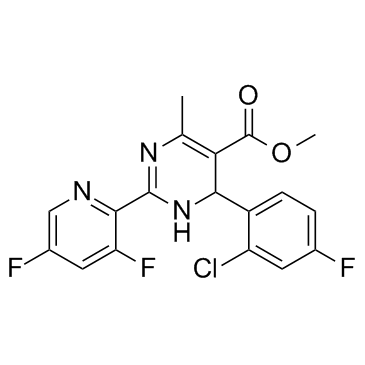Bay 41-4109 (racemate)
Modify Date: 2024-01-07 10:04:25

Bay 41-4109 (racemate) structure
|
Common Name | Bay 41-4109 (racemate) | ||
|---|---|---|---|---|
| CAS Number | 298708-79-9 | Molecular Weight | 395.768 | |
| Density | N/A | Boiling Point | N/A | |
| Molecular Formula | C18H13ClF3N3O2 | Melting Point | 126 °C | |
| MSDS | N/A | Flash Point | N/A | |
Use of Bay 41-4109 (racemate)BAY 41-4109 racemate is the racemate of BAY 41-4109. BAY 41-4109 is a potent inhibitor of human hepatitis B virus (HBV) with an IC50 of 53 nM. |
| Name | BAY41-4109 Racemic |
|---|---|
| Synonym | More Synonyms |
| Description | BAY 41-4109 racemate is the racemate of BAY 41-4109. BAY 41-4109 is a potent inhibitor of human hepatitis B virus (HBV) with an IC50 of 53 nM. |
|---|---|
| Related Catalog | |
| Target |
IC50: 53 nM (HBV)[1] |
| In Vitro | BAY 41-4109 is able to both accelerate and misdirect capsid assembly in vitro. Preformed capsids are stabilized by BAY 41-4109, up to a ratio of one inhibitor molecule per two dimers[2]. BAY 41-4109 is equally effective at inhibiting HBV DNA release and the cytoplasmic HBcAg level, with IC50s of 32.6 and 132 nM in HepG2.2.15 cells, respectively. HBV DNA and HBcAg are inhibited in a dose-dependent manner, indicating that the anti-HBV mechanisms are associated with and dependent on the rate of HBcAg inhibition[3]. |
| In Vivo | BAY 41-4109 reduces viral DNA in the liver and in the plasma dose-dependently with efficacy comparable to 3TC. BAY 41 -4109 reduces hepatitis B virus core antigen (HBcAg) in livers of HBV-transgenic mice. Pharmacokinetic studies in mice have shown rapid absorption, a bioavailability of 30% and dose-proportional plasma concentrations, about 60% in rats and dogs[1].BAY41-4109 inhibits virus production in vivo by a mechanism that targets the viral capsid[2]. |
| Cell Assay | Cellular metabolism is evaluated by MTT colorimetry. HepG2.2.15 cells are plated at a density of 2 × 103 cells per well in 96-well plates. After 8 d of treatment with different concentrations of each antiviral compound, 20 μL of MTT solution (5 g/L) are added to each well and incubated at 37°C for 4 h. Next, 150 μL of DMSO is added and stirred for 10 min to dissolve the crystals. Absorbance values are recorded at 490 nm by using an ELISA reader. The MTT values are calculated using the curve regression equation[3]. |
| Animal Admin | Mice: The HBV-transgenic mice are used in the study. Compounds (BAY 41-4109) are formulated as a suspension in 0.5% Tylose and administered per os to mice two times/day for a 28 day period. The 0.5% Tylose serves as a placebo. Six hours after the last treatment, the animals are sacrificed and livers are removed and immediately frozen for subsequent analysis. Blood is obtained by cardiac puncture of the anesthesized animals[1]. |
| References |
| Melting Point | 126 °C |
|---|---|
| Molecular Formula | C18H13ClF3N3O2 |
| Molecular Weight | 395.768 |
| Storage condition | 2-8℃ |
| methyl 4-(2-chloro-4-fluorophenyl)-2-(3,5-difluoro-2-pyridinyl)-6-methyl-1,4-dihydropyrimidine-5-carboxylate |
| Bay 41-4109 (racemate) |